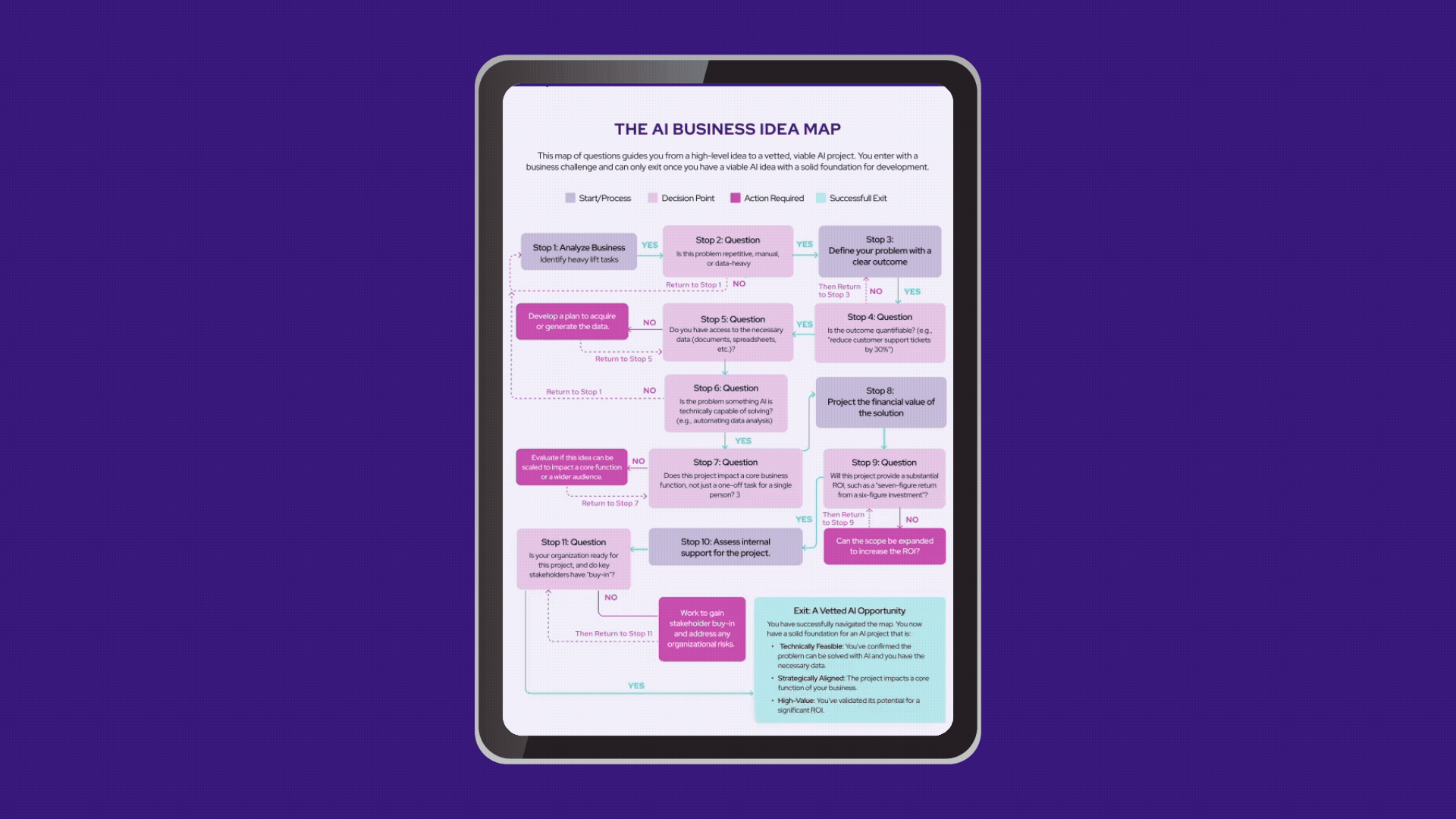
"We're either going to have a dot-com bubble–style collapse or an absolute revolution." "AI is the biggest bubble in history." "95% of AI pilots are failing." "AI will save us." "AI will destroy us all."
The chatter around artificial intelligence is louder than ever, fueled by headlines that swing between utopian promises and dystopian warnings. Everyone seems to have an opinion, from Wall Street analysts and venture capitalists to tech CEOs and futurists. The conversation is dominated by whether AI is a fleeting hype cycle or the dawn of a new era.
But while everyone is busy debating if the AI bubble will pop, few are talking about something more important for businesses: how to make sure you're not in it even if it does exist. This article is for those who want to move beyond the noise. We'll explore how companies can avoid the trap of speculative investment and instead, build an AI strategy that delivers real, measurable value.
Bubbles are not a new phenomenon: from 17th-century Dutch Tulip Mania to the 19th-century Railway Mania in the UK, and more recently, the dot-com bubble of the late 1990s. And nowadays, when a new promising advancement comes up every month, and everyone blindly believes that this is going to be the best thing since sliced bread, getting into a bubble is much easier. But what do we mean by those bubbles?

So, as a phenomenon, a bubble, or better to say an economic or financial bubble, is a period of time when companies and individuals invest in an asset more than the objective value of that asset is.
Therefore, what is believed to be an AI bubble means that businesses are overinvesting in AI, when the real impact of those investments is yet to be proved. This theory of AI being a bubble was mainly supported by a recent MIT study, where we could witness a heartbreaking statistics: 95% of generative AI pilots fail.
Additionally, famous tech voices such as Jeff Bezos and OpenAI CEO Sam Altman have also raised their concerns about the AI sector experiencing a bubble.
So, while the real existence of the AI bubble is a subject of discussion, there is still a risk for anyone to invest in AI and get zero ROI.
As an AI agency that works with companies that want AI in their products or processes, and see AI as a strategic asset, rather than a financial one, the topic we want to cover here is how and why the AI bubble may affect our clients and their businesses.
So, instead of discussing financial literacy and stock markets, we’ll take a look at this phenomenon from the perspective of those enterprises and startups that see how all their competitors rush into AI, and rush there as well.
Here is what puts their business into a risk of living and failing inside the AI bubble:
A pretty logical question you might ask yourself is whether you’re already there, in a bubble, and have chances to lose your investments with wrong decisions. So, to save you trouble, we’ve created a quiz that would show your chances of being in the AI bubble, and what to pay attention to so you can keep yourself farther from it.
As we've seen, the AI bubble isn't about the technology's potential, but about the risk that businesses will misapply it. To avoid getting swept up in the craze, you must shift your mindset from a speculative rush to a disciplined, strategic approach. This is the difference between an expensive experiment and a high-impact investment.
Here's how to ground your AI decisions in value.
Before you even think about a specific tool, model, or a flashy new feature, you must start with a fundamental question: What business problem are we trying to solve?
Many companies jump into AI because they see a cool product and then go looking for a problem to apply it to. This approach is a one-way ticket to the AI graveyard. Instead, conduct a "brutal self-audit" of your operations. Find the most painful, time-consuming, and expensive bottlenecks in your workflow. Your AI journey should begin here, with a clear, quantifiable objective that is more about solving your problems than it is about the technology itself.
And if you need a little help vetting your AI idea, you can always download our AI project map

A quick weekend project or a prototype built without a clear plan is almost guaranteed to fail. A successful AI implementation is a carefully engineered system.
The market is flooded with firms that promise to deliver AI solutions. But not all partners are created equal. A successful AI project requires more than just technical skill; it demands deep, specialized expertise.
Avoid the trap of hiring a large, generic consulting firm or an inexperienced team that will "vibe code" its way to a prototype without a clear business outcome. A true partner will have a proven track record of solving problems in your specific industry. They will ask the tough questions, help you define your goals, and ensure your project stays on a direct path toward a positive ROI.
For companies that don’t prioritize strategy and value over trends – yes, it will. In this article, we’ve listed what you can do to prevent yourself from getting caught in the AI bubble.
And If you need a partner who can help you build a profitable, value-driven AI solution, you can always contact NineTwoThree AI studio.
We're an award-winning AI studio with a proven playbook for building custom AI solutions that deliver measurable ROI in months, not years. We’ve successfully launched over 160 projects for clients and built our own startups, proving we understand what it takes to turn an idea into a scalable, profit-producing application.
Don’t get stuck in a pilot program that goes nowhere. Talk to us and find out how AI solutions can deliver positive ROI for your business.
"We're either going to have a dot-com bubble–style collapse or an absolute revolution." "AI is the biggest bubble in history." "95% of AI pilots are failing." "AI will save us." "AI will destroy us all."
The chatter around artificial intelligence is louder than ever, fueled by headlines that swing between utopian promises and dystopian warnings. Everyone seems to have an opinion, from Wall Street analysts and venture capitalists to tech CEOs and futurists. The conversation is dominated by whether AI is a fleeting hype cycle or the dawn of a new era.
But while everyone is busy debating if the AI bubble will pop, few are talking about something more important for businesses: how to make sure you're not in it even if it does exist. This article is for those who want to move beyond the noise. We'll explore how companies can avoid the trap of speculative investment and instead, build an AI strategy that delivers real, measurable value.
Bubbles are not a new phenomenon: from 17th-century Dutch Tulip Mania to the 19th-century Railway Mania in the UK, and more recently, the dot-com bubble of the late 1990s. And nowadays, when a new promising advancement comes up every month, and everyone blindly believes that this is going to be the best thing since sliced bread, getting into a bubble is much easier. But what do we mean by those bubbles?

So, as a phenomenon, a bubble, or better to say an economic or financial bubble, is a period of time when companies and individuals invest in an asset more than the objective value of that asset is.
Therefore, what is believed to be an AI bubble means that businesses are overinvesting in AI, when the real impact of those investments is yet to be proved. This theory of AI being a bubble was mainly supported by a recent MIT study, where we could witness a heartbreaking statistics: 95% of generative AI pilots fail.
Additionally, famous tech voices such as Jeff Bezos and OpenAI CEO Sam Altman have also raised their concerns about the AI sector experiencing a bubble.
So, while the real existence of the AI bubble is a subject of discussion, there is still a risk for anyone to invest in AI and get zero ROI.
As an AI agency that works with companies that want AI in their products or processes, and see AI as a strategic asset, rather than a financial one, the topic we want to cover here is how and why the AI bubble may affect our clients and their businesses.
So, instead of discussing financial literacy and stock markets, we’ll take a look at this phenomenon from the perspective of those enterprises and startups that see how all their competitors rush into AI, and rush there as well.
Here is what puts their business into a risk of living and failing inside the AI bubble:
A pretty logical question you might ask yourself is whether you’re already there, in a bubble, and have chances to lose your investments with wrong decisions. So, to save you trouble, we’ve created a quiz that would show your chances of being in the AI bubble, and what to pay attention to so you can keep yourself farther from it.
As we've seen, the AI bubble isn't about the technology's potential, but about the risk that businesses will misapply it. To avoid getting swept up in the craze, you must shift your mindset from a speculative rush to a disciplined, strategic approach. This is the difference between an expensive experiment and a high-impact investment.
Here's how to ground your AI decisions in value.
Before you even think about a specific tool, model, or a flashy new feature, you must start with a fundamental question: What business problem are we trying to solve?
Many companies jump into AI because they see a cool product and then go looking for a problem to apply it to. This approach is a one-way ticket to the AI graveyard. Instead, conduct a "brutal self-audit" of your operations. Find the most painful, time-consuming, and expensive bottlenecks in your workflow. Your AI journey should begin here, with a clear, quantifiable objective that is more about solving your problems than it is about the technology itself.
And if you need a little help vetting your AI idea, you can always download our AI project map

A quick weekend project or a prototype built without a clear plan is almost guaranteed to fail. A successful AI implementation is a carefully engineered system.
The market is flooded with firms that promise to deliver AI solutions. But not all partners are created equal. A successful AI project requires more than just technical skill; it demands deep, specialized expertise.
Avoid the trap of hiring a large, generic consulting firm or an inexperienced team that will "vibe code" its way to a prototype without a clear business outcome. A true partner will have a proven track record of solving problems in your specific industry. They will ask the tough questions, help you define your goals, and ensure your project stays on a direct path toward a positive ROI.
For companies that don’t prioritize strategy and value over trends – yes, it will. In this article, we’ve listed what you can do to prevent yourself from getting caught in the AI bubble.
And If you need a partner who can help you build a profitable, value-driven AI solution, you can always contact NineTwoThree AI studio.
We're an award-winning AI studio with a proven playbook for building custom AI solutions that deliver measurable ROI in months, not years. We’ve successfully launched over 160 projects for clients and built our own startups, proving we understand what it takes to turn an idea into a scalable, profit-producing application.
Don’t get stuck in a pilot program that goes nowhere. Talk to us and find out how AI solutions can deliver positive ROI for your business.

